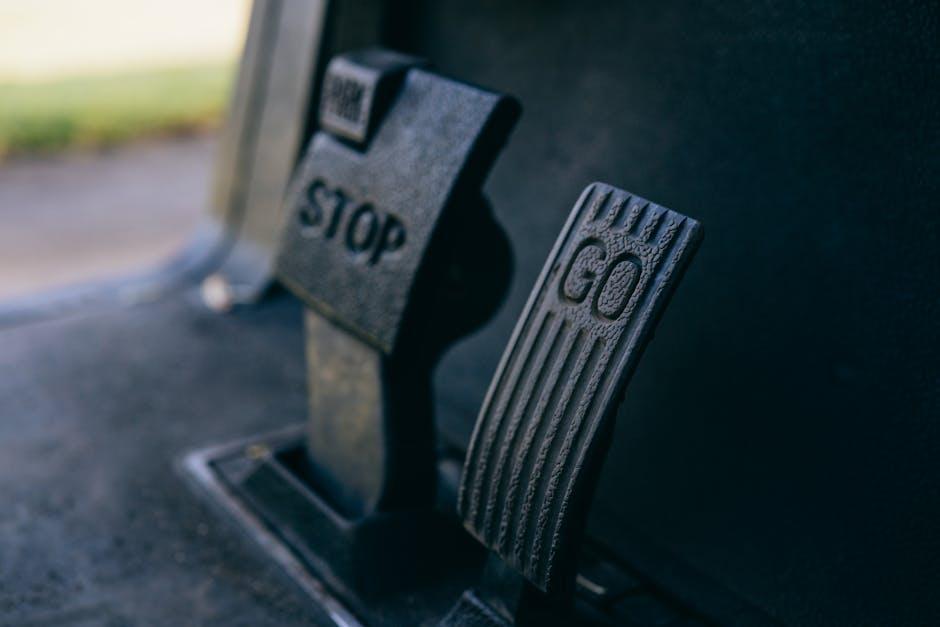Your car’s brakes are its unsung heroes, silently ensuring every journey ends safely. Yet, like all trusted allies, they occasionally send subtle signals when something’s amiss. Recognizing these signs early not only preserves your peace of mind but could prevent costly repairs and dangerous situations down the road. In this article, we’ll explore the key indicators that your brakes are ready for attention, helping you stay informed and in control behind the wheel.
Table of Contents
- Unusual Noises That Signal Brake Wear
- Understanding Brake Pedal Sensations and What They Mean
- Visible Wear and Tear to Check on Your Brake Components
- The Importance of Brake Fluid Levels and Quality
- How Vibrations During Braking Indicate Deeper Issues
- When Warning Lights and Dashboard Alerts Demand Attention
- Q&A
- Closing Remarks

Unusual Noises That Signal Brake Wear
When your brakes begin to wear down, your car might start communicating with you through unusual noises that are anything but subtle. A common auditory warning is a persistent squealing or high-pitched chirping, often caused by tiny metal wear indicators rubbing against the brake rotor. This isn’t just an annoyance; it’s a clear signal that your brake pads are nearing the end of their lifespan.
Another alarming sound to watch for is a grinding noise, which usually indicates that the brake pads are completely worn out, allowing metal to directly contact the rotor. This can seriously damage braking performance and increase repair costs. Below is a quick guide to common brake noises and their likely causes:
| Sound | Possible Cause | Urgency |
|---|---|---|
| Squealing | Worn brake pads with wear indicators | High |
| Grinding | Metal-on-metal contact, no brake pads left | Critical |
| Clicking | Loose or damaged brake components | Moderate |
| Thumping | Warped rotors or stuck calipers | Moderate |

Understanding Brake Pedal Sensations and What They Mean
When you press the brake pedal, the sensations you feel can reveal a lot about your vehicle’s brake system health. A soft or spongy pedal often indicates air in the brake lines or worn brake fluid, which reduces braking efficiency and compromises safety. Conversely, a hard pedal might suggest a problem with the brake booster or a line blockage, making it difficult to stop smoothly. If the pedal feels like it’s going straight to the floor, this could be a sign of a brake fluid leak or master cylinder failure, both of which require immediate attention.
Other unusual sensations include vibrations or pulsations through the pedal when braking, which are usually caused by warped rotors or uneven brake pad wear. Sometimes, you might notice a grinding or squealing noise when pressing the pedal—these noises are often early warnings of brake pad deterioration. Below is a quick reference table outlining common pedal sensations and their potential causes:
| Sensation | Likely Cause |
|---|---|
| Spongy/Soft pedal | Air in brake lines, contaminated brake fluid |
| Hard pedal | Brake booster issue, line blockage |
| Pedal sinks to floor | Brake fluid leak, master cylinder failure |
| Pedal vibration | Warped rotors, uneven brake pads |
| Squealing or grinding | Worn brake pads |

Visible Wear and Tear to Check on Your Brake Components
When inspecting brake components, a keen eye can save you from costly repairs down the road. Brake pads are often the first to show signs of distress—look for uneven wear, cracks, or a thickness of less than 3mm. Additionally, the rotors should be free of deep grooves, rust spots, or bluish discoloration caused by overheating. If you notice any of these, it’s a clear indication that the braking system isn’t performing optimally.
Besides pads and rotors, other visible elements shouldn’t be overlooked. Check the brake calipers for signs of leakage or corrosion, and observe the brake lines for cracks or bulges that could compromise fluid flow. Here’s a quick checklist to guide your inspection:
- Brake Pads: Uneven wear, below thickness threshold
- Rotors: Grooves, rust, discoloration
- Calipers: Leaks, corrosion
- Brake Lines: Cracks, bulges

The Importance of Brake Fluid Levels and Quality
Brake fluid is often the unsung hero of your vehicle’s braking system. Without the right level and quality of fluid, brakes can become sluggish or even fail completely. Because brake fluid transmits the force from your foot on the pedal to the brake pads, any contamination or loss in fluid can severely diminish your stopping power. Over time, moisture seeps into the system, reducing the fluid’s boiling point and increasing the risk of vapor lock, which can lead to dangerous brake fade or total loss of braking ability.
Maintaining brake fluid isn’t just about keeping it topped off—it’s about ensuring it stays clean and effective. Here are some critical signs that your brake fluid needs attention:
- Spongy brake pedal: A soft or mushy feel can indicate air or moisture in the system.
- Visible fluid leaks: Puddles or stains under your car near the wheels or brake components.
- Brake warning light: Modern cars often alert you when fluid levels are dangerously low.
- Reduced brake responsiveness: You may find you need to press the pedal harder than usual.
| Brake Fluid Warning Sign | Potential Cause | Recommended Action |
|---|---|---|
| Mushy Pedal | Air in brake lines | Brake fluid bleed and replacement |
| Brake Warning Light | Low fluid level | Check and top off fluid immediately |
| Visible Leaks | Damaged seals or lines | Inspect and repair leaking parts |
| Increased Stopping Distance | Contaminated fluid | Flush and replace fluid |

How Vibrations During Braking Indicate Deeper Issues
When your car trembles or shakes as you press the brake pedal, it’s more than just an uncomfortable nuisance—it’s a red flag signaling potential internal problems. These vibrations often stem from uneven brake rotor surfaces caused by excessive heat buildup or wear. Over time, this unevenness can lead to reduced braking efficiency and increased stopping distance, jeopardizing your safety. Additionally, worn brake pads or misaligned calipers can contribute to this unsettling feedback, hinting at a need for immediate inspection and repair.
Ignoring these shakes can escalate the issue, possibly affecting your vehicle’s suspension or tires due to irregular stress distribution. Some common consequences of unaddressed braking vibrations include:
- Warped brake rotors
- Premature brake pad wear
- Alignment problems
- Damage to wheel bearings
Understanding the root cause early means you can avoid costly repairs and maintain smoother, safer stops every time you drive.

When Warning Lights and Dashboard Alerts Demand Attention
Encountering warning lights and dashboard alerts related to your braking system should never be ignored. Brake system warnings can include symbols like an exclamation mark inside a circle, a brake pad icon, or the ABS (Anti-lock Braking System) light illuminating unexpectedly. These indicators immediately signal that there’s a potential issue affecting your vehicle’s ability to stop safely. Driving with these alerts active not only risks further damage to your brake components but also compromises your safety and the safety of others on the road.
Some common dashboard alerts and what they suggest:
- Brake Warning Light: Could indicate low brake fluid or worn brake pads.
- ABS Light: Signals a possible problem with the anti-lock braking system.
- Traction Control Warning: May highlight issues that affect braking performance in slippery conditions.
| Warning Light | Possible Cause | Urgency |
|---|---|---|
| Brake System | Low brake fluid or worn pads | High |
| ABS | Faulty sensors or ABS malfunction | Medium |
| Traction Control | Slippery road or system error | Medium |
Q&A
Q&A: Signs Your Car Needs Brake Repairs
Q1: How can I tell if my brakes are starting to fail?
A1: One of the clearest signs is an unusual noise—squealing, screeching, or grinding—when you press the brake pedal. These sounds often mean your brake pads are worn down and need replacement before they damage other components.
Q2: Is a vibrating brake pedal a warning sign?
A2: Absolutely. If you feel a pulsation or shaking through the brake pedal when slowing down, it could mean your brake rotors are warped or unevenly worn. This uneven surface creates vibrations that should be inspected promptly.
Q3: What if my car pulls to one side when braking?
A3: This is a definite red flag. Uneven braking can indicate issues like uneven brake pad wear, a stuck caliper, or even problems with the brake fluid. It’s essential to have a mechanic evaluate the brake system immediately for your safety.
Q4: Can a soft or spongy brake pedal indicate needed repairs?
A4: Yes. If the brake pedal feels soft, sinks too close to the floor, or requires more effort to stop the car, there might be air in the brake lines, leaking brake fluid, or worn components. This reduces braking efficiency and requires urgent attention.
Q5: Should I worry about increased stopping distances?
A5: Increased stopping times mean your brakes are not performing optimally. This can be due to worn pads, glazed rotors, or low brake fluid levels. Any noticeable change in how quickly your car stops calls for a brake inspection.
Q6: Are dashboard warning lights a reliable indicator?
A6: Yes, many modern cars have brake warning lights that illuminate when there’s an issue such as low brake fluid or worn brake pads. Don’t ignore these alerts—they’re your car’s way of asking for a brake check.
Q7: Can I delay brake repairs if everything seems fine?
A7: It’s risky. Brake components wear down over time, sometimes without obvious symptoms at first. Regular inspections and timely repairs help maintain safety and avoid costly damage down the road.
Q8: What regular maintenance can prevent brake trouble?
A8: Keeping an eye on your brake fluid level, listening for unusual noises, and scheduling periodic brake inspections can keep your braking system healthy. Promptly addressing early signs keeps your car safe and stops minor issues from becoming major repairs.
Brake issues can creep up quietly or announce themselves loudly. Knowing these signs helps you stay ahead, ensuring your car stops when you need it most.
Closing Remarks
In the rhythm of the road, your brakes are the silent conductors ensuring every stop is safe and smooth. Recognizing the subtle cues—whether it’s an unusual noise, a change in pedal feel, or that stubborn squeal—can make all the difference between a routine drive and an unexpected hazard. By tuning in to these warning signs early, you not only protect your vehicle but also safeguard your journey ahead. After all, when it comes to braking, it’s better to be proactive than reactive—because every great adventure deserves a confident and secure pause.

